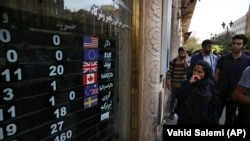Despite reports that the value of the Iranian rial is rising, fifty Iranian economists have called on the government to shut down "the secondary forex market," an arrangement the economists say has "pushed millions of Iranians below the poverty line."
In a letter to the heads of the three branches of the government, the economists warned that the creation of the secondary market has lifted the control on the foreign exchange rates and brought about an inflation rate of 60 percent.
The Rouhani administration created the secondary forex market in July after admitting the failure of imposing a single rate on the forex market. The secondary market brought about a system with three different rates of exchange.
Based on this system, there is one government rate of 42,000 rials to the US dollar, a free market rate determined by the market on a daily basis, and a secondary market where exporters offer the foreign currency they have earned abroad at a rate agreed upon with buyers.
Suspecting that exporters of petrochemical products, minerals, steel and other goods who received dollars at the cheap government rate to produce their output, sell the resulting foreign currency they earned from exports at a higher price at the market, making their profit three to four times higher at the expense of making the Iranian economy poorer.
Most big oil and manufacturing companies either are connected with the Islamic Revolution Guards (IRGC) or regime insiders and the economists are alluding to the danger of corruption in the forex arrangement.
This is the second time the economists are calling for the closure of the secondary forex market. They issued their first warning in August when they said the arrangement would create an opportunity for profiteers to take advantage of their links to the centers of power in the country.
In the new letter, the economists warned that continued activity of the secondary forex market can lead to a "national catastrophe unprecedented during the past 75 years," adding that this could lead to at least one million job losses.
The economists accused the government of selling foreign currency at high price in order to make ends meet. This comes while the Rouhani administration's declared policy is one of reducing exchange rates.
Last week, the rate of exchange of every US dollar at the Tehran market neared 200,000 rial. However, rumors going around in Tehran Monday evening October 1 indicated a sharp rise in the value of rial against the dollar. But many on social media say there are no real transactions in the market that would back the rumor.
Nevertheless, many are afraid that even an unlikely real in the value of rial would not bring down the prices of commodities after the skyrocketing rise of the past month.
Reports coming from Tehran Tuesday afternoon October 2 indicated that money changers refused to buy or sell foreign currencies although some had announced a lower rate of exchange for US dollar, around 110,000 rials per dollar.
The Iranian state TV's rolling news channel IRINN quoted the Central Bank in its afternoon bulletin as saying that certain Bank branches in Tehran have been ordered to buy foreign currency, but the bulletin did not mention any particular rate or branch. The news came while bank branches close before 4 pm, some before 3 pm.
Media have characterized the economists who signed the letter as "Islamic leftist and institutionalist," although some conservative figures such as Ahmad Tavakoli and Gholamreza Mesbahi Moghaddam are also among the signatories.
Meanwhile Central Bank Governor Abdolnasser Hemmati told reporters in Tehran that out of $23 billion earned from non-oil exports, only $4 billion has returned to the Iranian economy.
However, he did not elaborate on the fate of the $19 billion that has apparently disappeared.
The economists had previously called for the withdrawal of military institutions from economic activities, introducing tax reforms, merger of major banks and some other policies to help low-income strata of the population to survive the ongoing crisis.
There is no indication that any one of the suggestions made by economists have been taken on board by the government so far.



